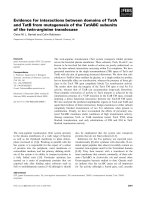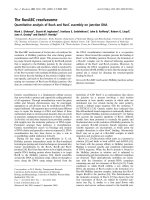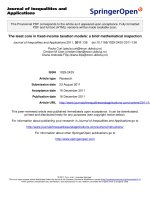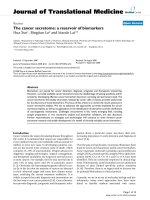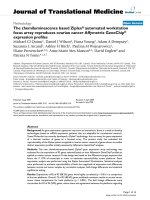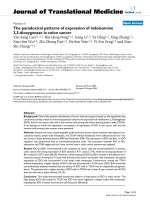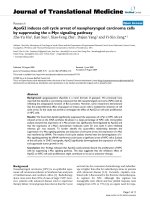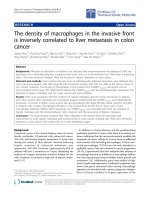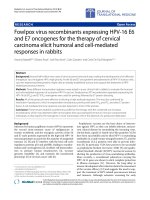báo cáo hóa học:" The cross-sectional associations between sense of coherence and diabetic microvascular complications, glycaemic control, and patients’ conceptions of type 1 diabetes" pot
Bạn đang xem bản rút gọn của tài liệu. Xem và tải ngay bản đầy đủ của tài liệu tại đây (264.42 KB, 8 trang )
RESEARC H Open Access
The cross-sectional associations between sense of
coherence and diabetic microvascular
complications, glycaemic control, and patients’
conceptions of type 1 diabetes
Aila J Ahola
1,2,3
, Markku Saraheimo
1,2
, Carol Forsblom
1,2
, Kustaa Hietala
1,2
, Per-Henrik Groop
1,2*
,
the FinnDiane Study Group
Abstract
Background: Sense of coherence (SOC) has been associated with various self-care behaviours in the general
population. As the management of type 1 diabetes heavily relies on self-management, the SOC concept could also
prove important in this populatio n. This paper is a report of a study conducted among patients with type 1
diabetes to assess the associations between SOC and glycaemic control, microvascular complications, and patients’
conceptions of their disease.
Methods: Altogether 1,264 adult patients (45% men, age range 18-82 years) with type 1 diabetes participated in
this cross-sectional study. SOC was evaluated using a 13-item SOC questionnaire. Standardized assays were used to
determine HbA
1c
. Nephropathy status was based on albumin excretion rate and retinal laser-treatment was used as
an indication of severe retinopathy. Patients’ subjective conceptions of diabetes were studied using a
questionnaire.
Results: Higher SOC scores, reflecting stronger SOC, were associated with lower HbA
1c
values. Strong SOC was
independently associated with reaching the HbA
1c
level <7.5%. Adjusting for diabetes duration, age at onset,
socioeconomic status and HbA
1c
, weak SOC was associated with the presence of nephropathy among men, but
not women. No associations were observed between SOC and severe retinopathy. Four dimensions describing
patients’ conceptions of HbA
1c
, complications, diabetes control and hypoglycaemia were formed from the diabetes
questionnaire. Weak SOC was independently associated with worse subjective conceptions in the dimensions of
HbA
1c
and hypoglycaemia. Furthermore among men, an association between weak SOC and the complications
factor was observed.
Conclusion: Interventions to improve patients’ SOC, if available, could improve patients’ metabolic control and
therefore also reduce the incidence of diabetic complications.
Introduction
Type 1 diabetes is a chronic disease that is frequently
associated with severe vascular complications [1].
Importantly, diabetic complications account for the
major morbidity and mortality associated with the dis-
ease [2]. Therefore prevention of these complications, by
means of strict glycaemic control, is of major impor-
tance in the management of type 1 diabetes [3]. Con-
scientious daily self-care practices, that include frequent
blood glucose monitoring and meticulous meal plan-
ning, are strongly emphasized [4,5], b ut despite these
meeting the treatment goals has shown to be fairly diffi-
cult [6]. Therefore, identification of factors that contri-
bute to the improved diabetes management would be of
specific importance.
* Correspondence:
1
Folkhälsan Institute of Genetics, Folkhälsan Research Center, Biomedicum
Helsinki, Finland
Full list of author information is available at the end of the article
Ahola et al. Health and Quality of Life Outcomes 2010, 8:142
/>© 2010 Ahola et al; lic ensee BioMed Central Ltd. This is an Open Access article distributed under the terms of the Creative Commons
Attribution License ( which permits unrestricted use, distribution, and reproduction in
any medium, provided the original work is properly cited.
The theoretic al model of the sense of coherence
(SOC) has been associated with various self-care beha-
viours including cigarette smoking, physical activity,
food selection and oral health-related behaviours [7-9].
Ant onovsky identified and advo cated the use of SOC as
a central part of his salutogenic approach that explains
why some individuals stay healthy despite of encounter-
ing major stressors, while others do not [10]. In this
model, health and disease form a continuum from
“ease” to “ disease”, rather than are seen as a dichoto-
mous variable. Whether an individual moves from one
end to another, along this continuum, depends on the
encountered stressors and the set of coping resources
available. According to Antonovsky, comprehensibility,
mana geability and meaningfulness are the three compo-
nents that constitute the SOC. These components
express the extent to which one has a pervasive feeling
of confidence that the confronted stimuli are structured
and predictable (comprehensible), worthy of engagement
(meaningful), and that an individual has sufficient
resources to meet the demands of life (manageable).
ThestrongertheSOC,themorelikelyanindividualis
able to select appropriate coping strategies and therefore
to move towards the “ease” end of the continuum.
Considering that the management of type 1 diabetes
relies heavily on self-management practices, the SOC
construct could also prove valuable in this patient
group. Currently the SOC is, however, rather unex-
plored among patients with type 1 diabetes and the
available data are inconsistent. While in two small stu-
dies conducted among patients with insulin-dependent
diabetes, SOC was not a ssociated with the metabolic
control [11,1 2], in a mixed population consisting of
patients with type 1 and type 2 diabetes, strong SOC
was associated with better glycaemic control [13].
Due to the limited and conflicting evidence obta ined
thus far, we aimed to investigate whether weak SOC is
associated with glycaemic control and microvascular
complications among patients with type 1 diabetes.
Additionally, the association between SOC and patients’
subjective conceptions of the disease was investigated.
We hypothesised that weak SOC is associated with poor
metabolic control and the presence of microvascular
complications. Furthermore we expected w eak SOC to
be reflected in more negative self-reports of diabetes
and its management.
Methods
Cross-sectional data from a total of 1,264 patients with
type 1 diabetes participating in the Finnish Diabetic
Nephropathy Study (FinnDiane) wer e included. S ince its
launch in 1997, data from more t han 4,800 patient s
have been collected in the FinnDiane Study. However,
the collection of SOC data did not start until September
2003. In the present study, all patients providing SOC
data by April 2010 were included. The study protocol
was approved by the Ethics Committee of the Hospital
District of Helsinki and Uusimaa, and patients gave
written informed consent prior to participation.
During the visits, patients were provided with ques-
tionnaires to be completed at home. First , Antonovsky’s
13-item SOC que stionnaire was applied [10]. The ques-
tionnaire has shown to be reliable, valid and cross cultu-
rally applicable [14]. On a seven point Likert-type scale,
patients select a reply for each question between two
extremes (i.e. very often and never). After a reverse
scoring for questions 1, 2, 3, 7, and 10, a ll items were
summed to obtain the SOC score. Patients that did not
provide answers to all questions were excluded (n = 47).
In the questionnaire, potential scores range between 13
and 91; the higher the score, the stronger the SOC. The
ordinal SOC score was used as a continuous variable
and patients were additionally divided into quartiles
based on their SOC score, as previously seen [8]. The
lowest quartile was considered to have weak SOC, and
was compared to the remaining patients.
Second, in a structured questionnaire, patients were
asked to provide answers to various diabetes specific
questions (Additional file 1, Diabetes questionnaire).
The questionnaire was designed for th e purpose of this
study by a panel of experien ced physicians who actively
participate in the clinical work. A special emphasis was
placed on items that are of clinical relevance in patients’
daily lives. Amongst others, questions inquiring patients’
satisfaction with their current HbA
1c
and insulin regi-
men were included. Patients were instructed to select
the most appropriate answer from the predetermined
alternatives.
HbA
1c
was determined locally by standardized assays.
Serum lipid and lipoprotein concentrations were mea-
sured as previously described [15] . Following a 10-min-
ute rest, blood pressure was measured twice with two
minutes intervals in the sitting position. Blood pressure
was calculated as a mean of these measurements.
Patients’ height and weight were measured in light
clothing and body mass in dex (BMI) was calculated (kg/
m
2
). The assessment of renal status was based on urin-
ary albumin excretion rate ( AER) in at least two out of
three timed 24-h or overnight urine collections. P atients
were classified according to the following criteria: nor-
mal albumin excretion rate (AER <20 μg/min or <30
mg/24 h), microalbuminuria (AER ≥20 and <200 μg/min
or ≥30 and <300 mg/24 h), macroalbuminuria (AER
≥200 μg/min or ≥300 mg/24 h), or end -stage re nal
disease (ESRD) (undergoing dialysis or having had a
kidney transplant). Diabetic nephropathy was defined as
macroalbuminuria or ESRD. Data on retinopathy
were obtained from medical rec ords and retinal
Ahola et al. Health and Quality of Life Outcomes 2010, 8:142
/>Page 2 of 8
laser-treatment was used as an indication of severe reti-
nopathy [16]. Self-reported data for smoking and social
class (grouped as unskilled blue collar, n = 152; skilled
blue collar, n = 390; lower white collar, n = 227; upper
white collar, n = 182; farmers, n = 4; and others, n =
46) were collected. Unskilled blue co llar workers were
classified as having a low socioeconomic status (SES).
Statistical analyses
Descriptive statistics are reported as percentages for
categorical data, mean ± SD for normally distributed
continuous data, and median (interquartile range) for
non-normally distributed continuous data. Group com-
parisons were performed using the Chi-squared test,
independent-sample t-test, and Mann Whitney U-test,
as appropriate. Spearman rank order correlation coeffi-
cient was calculated to study the relationship between
SOC score and HbA
1c
, as they were not normally dis-
tributed. Logistic regression analyses were used to
explore the independent associations between weak
SOC and complications and glycaemic control. Explora-
tory factor analysis (maximal likelihood and varimax
rotation) was used to identify underlying constructs
within the diabetes questionnaire. The number of fac-
tors identified was based on ei genvalues >1.0. Items
were considered to load highly i f they had a factor load-
ing |≥0.20| with a particul ar factor. The factor score was
the sum of the scores for all items associated with a
given factor multiplied by i ts corresponding factor load-
ing. These scores were used as dependent variables in
analyses. The questionnaire’s reliability was assessed cal-
culating Cronbach’s a, and a > 0.60 was deemed accep-
table. Factorial analysis of variance was used to study
the associations between SOC status and the measured
HbA
1c
and the factors formed in the factor analysis. In
the analyses, gender interactions were evaluated and,
when applicable, separate analyses for men and women
were performed. All data were analyzed using SPSS 17.0
for Windows (SPSS, Chicago, IL).
Results
A total of 61% of the patients returned the questionnaires.
The ones returning the questionnaire were older (mean
age 45 ± 12 years vs. 42 ± 13 years, p < 0.001) and had
longer diabetes duration (28 ± 13 vs. 24 ± 13, p < 0.001)
compared to those not returning the questionnaire. The
proportion of men was higher among the non-responders
(55% vs. 45%, p < 0.001). Moreover, the n on-responders
were more frequently smokers (24% vs. 19%, p = 0.008)
and had mor e frequently low socioeconom ic status (20%
vs. 15% p = 0.013). No differences were observed in any of
the laboratory values, blood p ressure, BMI, and in the
nephropathy or retinopathy status.
Data from a total of 1,264 patients (45% men) are
included (Table 1). Mean age was 45 ± 12 yea rs and
duration of diabetes 28 ± 13 years. Based on the lowest
quartile, a cut-off point of <63 wa s set for the weak
SOC, while the median SOC score in t he population
was 73. Compared to men, women had lower median
SOC scores [74 (65 - 81) vs. 72 (61 - 80), p = 0.003].
Moreover, the prevalence of weak SOC was higher
among women (28% vs. 20%, p = 0.001).
SOC and metabolic control
The SOC score was negatively associated with the mea-
sured HbA
1c
(r = -0.091, p = 0.002). The median HbA
1c
was hig her among those with weak SOC [8.1 (7.5 - 9.0)
vs. 8.0 (7.2 - 8.7), p =0.004].Moreover,patientswith
strong SOC more frequently achieved an HbA
1c
level
below 7.5% (32% vs. 24%, p = 0.016).
SOC, nephropathy and retinopathy
Nephropathy status w as evaluated in 1 ,118 pati ents. A total
of 276 (25%) patients had nephropathy judged by the pre-
sence of either macroalbuminuria or ESRD. Weak SOC
was observed in 29% and 24% of the patients wi th and
without nephropathy (p = 0.110). No difference in the
median SOC score was observed between patients with
and without nephropathy [71 (59 - 79) vs. 73 (63 - 80), p =
0.089]. Data on retinopa thy were available f rom 1,239
patients. Altogether 461 (37%) patients had severe retino-
pathy. Weak SOC was an equally common finding among
patients with and without severe retinopathy (27% vs. 23%,
p = 0.134, respectively), and the respective median SOC
Table 1 Description of the study population
Weak SOC
a
Strong SOC p
n = 311
(25%)
n = 953
(75%)
Men, n (%) 113 (36) 453 (48) 0.001
Age, years 44 ± 12 45 ± 12 0.266
Diabetes duration, years 29 (19 - 38) 28 (18 - 37) 0.270
Current smoking, % 21 18 0.273
Low SES
b
, % 15 15 1.000
HbA
1c
, % 8.1 (7.5 - 9.0) 8.0 (7.2 - 8.7) 0.004
Total cholesterol, mmol/l 4.6 (4.0 - 5.1) 4.4 (4.0 - 5.1) 0.352
HDL cholesterol, mmol/l 1.8 (1.4 - 2.1) 1.7 (1.4 - 2.0) 0.551
Triglycerides, mmol/l 0.9 (0.6 - 1.3) 0.9 (0.7 - 1.3) 0.842
BMI, kg/m
2
25 (23 - 28) 25 (23 - 28) 0.625
Systolic blood pressure, mmHg 135 (124 - 151) 137 (125 - 151) 0.204
Diastolic blood pressure,
mmHg
80 (71 - 85) 79 (72 - 85) 0.941
Data are shown as frequency (%) for categorical variables, mean ± SD for
continuous normally distributed variables, and median (interquartile range) for
continuous non-normally distributed variables.
a
SOC = sense of coherence;
values <63 signify weak SOC,
b
Low socioeconomic status (unskilled blue
collar workers).
Ahola et al. Health and Quality of Life Outcomes 2010, 8:142
/>Page 3 of 8
score was no different [72 (61 - 80) vs. 73 (63 - 80),
p = 0.351].
Unlike among women, weak SOC was independently
associated with nephropathy in men when adjusted for
diabetes duration, age at onset, socioeconomic status
and HbA
1c
(Table 2). No association was observed
between weak SOC and retinopathy in either sex. After
adjustments with gender, diabetes duration, age at
onset, socioeconomic status and HbA
1c
, weak SOC was
associated with the measured HbA
1c
values above 7.5%.
Factor analysis and reliability of the diabetes
questionnaire
Four factors consisting of questions with a high degree
of intercorrelation were formed. The first factor called
“conceptions of HbA
1c
“ (eigenvalue 2.71, explained var-
iance 19%), consisted o f questions regarding patient’ s
recollection o f the last measured HbA
1c
value, patient’ s
perception of whether that value was at a good, satisfac-
tory or high level, and whether patient was satisfied
with that HbA
1c
level. The second factor was named
“ complica tions” (eigenvalue 2.17, explained varia nce
15%) and included questions about the numbers of doc-
tors’ and nurses’ appointments during the past year due
to non-diabetes related reasons, the presence of other
chronic illnesses and patient’ s perception of how much
diabetes-related complications cause disturbance. Ques-
tions on th e frequencies of diabetes-related doctors’ and
nurses’ visits during the past year formed the “diabetes
control” factor (eigenvalue 1.42, explained variance
10%). Finally, the factor “ hypoglycaemia” (eigenvalue
1.18, explained variance 8%) was formed of questions on
patient’s perceived fear of hypoglycaemia, satisfaction
with the current insulin regimen, the frequency of
experiencing hypoglycaemic episodes, patient’ s percep-
tion of how much diabetes per se or its treatment dis-
turbs e veryday life and patient’ s perception of how
much diabetes-related complications cause disturbance.
In all the four factors, higher factor scores denote less
favourable situation, e.g. higher self-reported HbA
1c
,
perception of it being at a high level and lower satisfac-
tion with the current HbA
1c
level in the conceptions of
HbA
1c
-factor. The reliability analysis of the question-
naire gave a Cronbach’s alpha value of 0.625.
SOC and patients’ conceptions of diabetes
The SOC score was negatively associated with three fac-
tor scores; co nceptions of HbA
1c
(r = -0.116, p < 0.001),
complications (r = -0.163, p < 0.001), and hypoglycaemia
(r = -0.342, p < 0.001), suggesting that patients with
weak SOC have less favourable conceptions of these dia-
betes related dimensions.
Using a factorial analysis o f variance, weak SOC was
associated with the measured HbA
1c
when adjusted for
gender, diabetes duration, age at onset, and SES
(Table 3). Of the four factors formed, weak SOC was
independently associated with the conceptions of HbA
1c
and hypoglycaemia. Furthermore among men, weak
SOC was associated with the complications factor.
Discussion
According to Antonovsky, SOC is established during the
childhood and adolescence and having developed, he
considered it fairly stable quality throughout the
Table 2 The association between weak sense of coherence and nephropathy, severe retinopathy and HbA1c level.
Nephropathy Severe retinopathy HbA
1c
≥7.5%
Men Women Men Women Men and women combined
Model 1
Weak SOC 1.97 (1.26 - 3.08) 1.07 (0.69 - 1.66) 1.53 (1.01 - 2.33) 1.15 (0.81 - 1.63) 1.44 (1.06 - 1.97)
Gender, 1 = male NA NA NA NA 0.84 (0.65 - 1.08)
Model 2
Weak SOC 1.97 (1.15 - 3.05) 1.03 (0.65 - 1.62) 1.39 (0.85 - 2.27) 1.20 (0.80 - 1.81) 1.43 (1.04 - 1.95)
Gender, 1 = male NA NA NA NA 0.83 (0.64 - 1.08)
Diabetes duration, years 1.07 (1.05 - 1.09) 1.04 (1.02 - 1.06) 1.11 (1.09 - 1.13) 1.10 (1.08 - 1.12) 0.99 (0.98 - 1.00)
Age at onset, years 0.99 (0.97 - 1.01) 0.95 (0.92 - 0.98) 0.99 (0.97 - 1.01) 0.94 (0.92 - 0.97) 0.99 (0.98 - 1.01)
Model 3
Weak SOC 2.11 (1.13 - 3.95) 0.80 (0.44 - 1.45) 1.15 (0.63 - 2.11) 1.23 (0.75 - 2.03) 1.52 (1.07 - 2.17)
Gender, 1 = male NA NA NA NA 0.86 (0.64 - 1.15)
Diabetes duration, years 1.10 (1.07 - 1.13) 1.04 (1.01 - 1.06) 1.12 (1.09 - 1.15) 1.11 (1.08 - 1.13) 0.99 (0.98 - 1.01)
Age at onset, years 1.00 (0.94 - 1.03) 0.95 (0.92 - 0.99) 1.00 (0.97 - 1.03) 0.95 (0.92 - 0.98) 1.00 (0.98 - 1.01)
Low SES, 1 = yes 1.50 (0.76 - 2.97) 1.96 (0.95 - 4.05) 1.14 (0.59 - 2.21) 1.39 (0.70 - 2.75) 0.81 (0.54 - 1.23)
HbA
1c
1.37 (1.12 - 1.69) 1.32 (1.08 - 1.61) 1.36 (1.11 - 1.67) 1.17 (0.97 - 1.40) NA
Data are presented as odds ratio (95% confidence interval). Weak SOC, weak sense of coherence; Low SES, low socioeconomic status (unskilled blue collar
workers); NA, not applicable. Logistic regression analysis. Significant results are highlighted in bold.
Ahola et al. Health and Quality of Life Outcomes 2010, 8:142
/>Page 4 of 8
adulthood [10]. Importantly, SOC has been associated
with health-promoting behavi our, such as more prudent
dietary habits and a reduced likelihood of being a
smoker and physically inactive [7]. As the successful
management of type 1 i s heavily dependent on patient’s
self-management, we hypothesized that SOC could also
play an important role among these pat ients. Indee d, in
the current study we observed that weak SOC was inde-
pendently associated with poore r glycaemic control and
with the pre sence of nephropathy amon g men. Our
results, t herefore, give some support to the SOC theory
that suggests that patients with strong SOC might be
better able to use any resources available to enhance
their well-being.
In the current study, weak SOC was not a ssociated
with severe retinopathy in either sex. However, among
men, weak SOC was associated with nephropathy even
after adjustment with more established risk factors, such
as diabetes duration and HbA
1c
.Thereasonforthe
observed gender difference in the association between
SOC and nephropathy is not known. A potential contri-
buting factor might, however, b e the fact that compared
to wo men, men were more frequently smokers. Further
adjustment with smoking did not, however, alter the
results (data not shown). The results are intriguing also
because, as seen also in some other studies [7,12],
women tend to have lower SOC scores and thus have a
higher prevalence of weak SOC. Our results suggest
that, despite lower SOC scores, women as opposed to
men might be more able to engage in health promoting
behaviours. This also raises the question whether differ-
ent cut-off values for men and women should be used
when defining weak SOC.
Previously Richardson et al. observed a lower mean
SOC score among patients with two or more co mplica-
tions as opposed to those with less complications [12].
Except for this report, studies on the association
between SOC and diabetic complications are scarce.
However, a number of study reports on SOC and meta-
bolic control are available. Two of these studies,
conducted among patients with type 2 diabetes,
found no direct association between SOC and HbA
1c
[17,18]. Two further studies among patients with insu-
lin-dependent diabetes also concluded that SOC and
glycaemic control are not correlated [11,12]. Only evi-
dence, to our knowledge, relating SOC to glycaemic
control comes from Cohen and Kanter [13]. According
to them, however, the relationship was not direct but
was mediated via adherence to self-care behaviours and
psychological distress.
In clinical practice, monitoring glyc aemic control and
any signs of vascular complications are of major impor-
tance. Beyond these hard end points, however, patient s’
subjective conceptions of their disease are also impor-
tant. Indeed, some of the major observations in the
studies of SOC and diabetes have dealt with acceptance
of the disease and the subjective assessment of health
state. Based on the results from these previous studies,
patients with type 1 diabetes who have higher SOC
scores also have a higher degree of disease acceptance
[12] and also les s problems in rel ation to the e nviron-
ment, tedium and well being [11].
In the curren t study, patients’ conceptions of diabetes
were studied using a questionnaire from which, using
factor analysis, four dimensions were identified. Of these
dimensions, weak SOC was associated with worse con-
ceptions of HbA
1c
meaning that their latest self-reported
HbA
1c
measurement was higher, they more frequently
considered their HbA
1c
being at poor level, and they
less frequently were satisfied with their HbA
1c
level. Of
the other dimensions, weak SOC was also a ssociated
with the hypoglycaemia-facto r, that amongst other items
contained questions about fear of hypoglycaemia and
satisfaction with the current insulin regimen. Further-
more, men also showed an association between weak
SOC a nd the complications-factor. These results are in
line with previous studies that reported that strong SOC
was associated with better s elf-asse ssed health [1 8] and
lower fear of hypoglycaemia [17]. In diabetes, fear of
hypoglycaemia is specifically important as it is not only
Table 3 The association between weak sense of coherence, HbA1c and four dimensions of the diabetes questionnaire.
Model 1 Model 2
F(df
M
,df
R
) p h
2
F(df
M
,df
R
) p h
2
Measured HbA
1c
F(1, 1109) = 8.80 0.003 0.008 F(1, 865) = 6.03 0.014 0.007
Conceptions of HbA
1c
F(1, 1241) = 14.14 < 0.001 0.011 F(1, 980) = 9.34 0.002 0.009
Complications
Men F(1, 552) = 27.81 < 0.001 0.048 F(1, 429) = 23.94 < 0.001 0.053
Women F(1, 687) = 3.55 0.060 0.005 F(1, 548) = 1.99 0.159 0.004
Diabetes control F(1, 1241) = 2.97 0.085 0.002 F(1, 980) = 1.61 0.205 0.002
Hypoglycaemia F(1, 1241) = 114.76 < 0.001 0.085 F(1, 980) = 80.00 < 0.001 0.075
Model 1 is adjusted for gender (except for complications), diabetes duration and age at onset of diabetes; Model 2 is further adjusted for socio-economic status.
Factorial analysis of variance
Ahola et al. Health and Quality of Life Outcomes 2010, 8:142
/>Page 5 of 8
a subjective nuisance, but it may also affect patients’
insulin regimen and eating habits. Indeed, it has been
suggested that fear of hypoglycaemia might promote
non-adherence beh aviour in order to avoid hypoglycae-
mic episodes [19]. Moreover, in a recent review, a signif-
icant negative impact between fear of hypoglycaemia
and diabetes management and metabolic control was
shown [20].
Our st udy ha s both strengths and limitations. A major
strength is the large number of patients included in this
study. Additionally, the diagnoses of diabetes and com-
plications were based on a physician’s evaluation rather
than on self-reported data, reducing the possibility of
misclassification. The major limitation is the cross-sec-
tional nature of the study design that limits the determi-
nation of temporal relationships. Although A ntonovsky
suggested that, after having established, SOC is a fairly
stable phenomenon, we do not know whether SOC is
indeed a primary feature or rather a consequence of gly-
caemic control or diabetic complications. There are cur-
rently some evidence to suggest that SOC could be
improved using psychological intervention [21,22].
Therefore longitudinal associations between SOC, and
glycaemic control and diabetic complications will need
to be addressed in t he future an alyses. This study may
further be limited by the fact that while SOC was stu-
died using a validated questionnaire, patients’ percep-
tions of diabetes were studied with a non-validated
questionnaire. When formulating the questionnaire, spe-
cial emphasis was placed on including items that are of
clinical relevance in patients’ daily lives. Of specific
importance is that many of these questions are also
addressed in actual clinical work, f or which we believe
our results may pro vide a valuable contribut ion.
Another potential limitation is that marital status was
not assessed in the current study. It can be speculated
that a spouse can also influence the individual’s self-care
behaviours and therefore have an effect on the outcome
measures. Finally, although we consider that the Finn-
Diane study population is a fairly representative of the
Finnish adult patients with type 1 diabetes, some selec-
tion bias favouring women and older individuals was
observed in the current study population. It is also pos-
sible that individuals with weak SOC and those with
more severe health problems were under represented,
an observation that is likely to attenuate the results.
In conclusion, strong SOC was associated with a bet-
ter metabolic control among men and women, and the
presence of nephropathy among men. Strong SOC was
also associated with better patients’ conceptions of their
disease. Interven tions to impro ve patients’ SOC, if avail-
able, could improve patients’ metabolic control and
therefore also reduce the risk of diabetic complications.
Appendix
The physicians and nurses participating in t he enrol-
ment of patients:
Anjalankoski Health Cent er: S. Koivula and T. Uggel-
dahl; Central Finland Central Hospital:T.Fors-lund,A.
Halonen, A. Koistinen, P. Koskiaho, M. Laukkanen, J.
Saltevo and M. Tiihonen; Cen tral Hospital of Åland
Islands: M. Forsen, H. Granlund, A C. Jonsson and B.
Nyroos; Central Hospital of Kanta-Häme: P. Kinn unen,
A. Orvola, T. Salonen and A. Vähänen; Central Hospital
ofKymenlaakso:R.Paldanius,M.RiiheläandL.Ryysy;
CentralHospitalofLänsi-Pohja:H.Laukkanen,P.
Nyländen and A. Sademies; Central Ostrobothnian Hos-
pital District: S. Ander son, B. A splund, U. Byskata, P.
Liedes, M. Kuusela and T. Virkkala; City of Espoo
Health Center (Espoonlahti): A. Nikkola and E. Ritola;
(Tapiola): M. Niska an d H. Saarinen; (Viherlaakso): A.
Lyytinen; City of Helsinki Heal th Center (Puistola): H.
Kari and T. Simonen; (Suutarila): A. Kaprio, J. Kärkkäi-
nen and B. Rantaeskola; (Töölö): P . Kääriäinen, J. Haaga
and A-L. Pietiläinen; City of Hyvinkää Health Center: S.
Klemetti, T. Nya ndoto, E. Rontu and S. Satuli-Autere;
City of Vantaa Health Center (Korso): R. Toivonen and
H. Virtanen; (Länsimäki): R. Ahonen, M. Ivaska-Suomela
and A. Jauhiainen; (Martinlaakso): M. Laine, T. Pellon-
pää and R. Puranen; (Myyrmäki): A. Airas, J. Laakso and
K. Rautavaara; (Rekola): M. Erola and E. Jatkola;
(Tikkurila): R. Lönnblad, A. Malm, J. Mäkelä and
E. Rautamo; Heinola HealthCenter:P.Hentunenand
J. Lagerstam; Helsinki University Central Hospital
(Department of Medicine, Division of Nephrology): D.
Cordin, J. Fagerudd, M. Feodoroff, O. Heikkilä, L. Kyllö-
nen, J. Kytö, K. Pettersson-Fernholm, M. Rosengård-Bär-
lund, M. Rönnback, L. Thorn and J. Wadén;
Herttoniemi Hospital: V. Sipilä; Hospital of Lounais-
Häme: T. Kalliomäki, J. Koskelainen, R. Nikkanen,
N. Savolainen, H. Sulonen and E. Valtonen; Iisalmi Hos-
pital: E. Toivanen; Jokilaakso Hospital: A. Parta and
I. Pirttiniemi; Jo rvi Hospital: S. Aranko, S. Ervasti,
R. Kauppinen-Mäkelin, A. Kuusisto, T. Leppälä, K. Nik-
kilä and L. Pekko nen; Jyväskylä Health Center:
K. Nuorva and M. Tiihonen; Kainuu Central Hospital:
S. Jokelainen, P. Kemppainen, A-M. Mankinen and
M. Sankari; Kerava Health Center: H. Stuckey and
P. Suominen; Kirkkonummi Health Center: A. L appalai-
nen, M. Liimatainen and J. Santahol ma; Kivelä Hospital:
A. Aimolahti and E. Huovinen; Koskela Hospital:
V. Ilkka and M. Lehtimäki; Kotka Health Center:
E. Pälikkö-Kontinen and A. Vanhanen; Kouvola Health
Center:E.KoskinenandT.Siitonen;KuopioUniversity
Hospital: E. Huttunen, R. Ikäheimo, P. Karhapää,
P. Kekäläinen, M. Laakso, T. Lakka, E. Lampainen,
L. Moilanen, L. Niskane n, U. Tuovinen, I. Vauhkonen
Ahola et al. Health and Quality of Life Outcomes 2010, 8:142
/>Page 6 of 8
and E. Voutilainen; Kuusamo Health Center: T. Kääriäi-
nen and E. Isopoussu; Kuusankoski Hospital: E. Kilkki, I.
Koskinen and L. Riihelä; Laakso Hospital, Helsinki: T.
Meriläinen, P. Poukka, R. Savolainen and N. Uhlenius;
Lahti City Hospital: A. Mäkelä and M. Tanner; Lapland
Central Hospital: L. Hyvärinen, S. Severinkangas and T.
Tulokas; Lappeenranta Health Center: P. Linkola and I.
Pulli; Lohja Hospital: T. Granlund, M. Saari and T. Salo-
nen; Länsi-Uusimaa Hospital: I M. Jousmaa and J.
Rinne; Loimaa Health Center: A. Mäkelä and P. Elor-
anta;MalmiHospital:H.Lanki,S.MoilanenandM.
Tilly-Kiesi; Mikkeli Central Hospital: A. Gynther, R.
Manninen, P. Nironen, M. Salminen and T. Vänttinen;
Mänttä Regional Hospital: I. Pirttiniemi and A-M. Hän-
ninen; North Karelian Hospital: U-M. Henttula, P. Kekä-
läinen, M. Pietarinen, A. Rissanen and M. Voutilainen;
Nurmijärvi Health Center: A . Burgos and K. Urtamo;
Oulaskangas Hospital: E. Jokelainen, P L. Jy lkkä, E.
Kaarlela and J. Vuolaspuro; Oulu Health Center: L. Hil-
tunen, R. Häkk inen and S. Keinänen -Kiu kaanniemi;
Oulu University Hospital: R. Ikäheimo; Päijät-Häme
Central Hospital: H. Haapamäki, A. Helanterä, S. Hämä-
läinen, V. Ilvesmäki and H. Miettinen; Palokka Health
Center: P. Sopanen and L. Welling; Pieksämäki Hospital:
V. Javtsenko and M. Tamminen; Pietarsaari Hospital:
M-L. Holmbäck, B. Isomaa and L. Sarelin; Pori City
Hospital: P. Ahonen, P. Merensalo and K. Sävelä; Porvoo
Hos pital: M. Kallio, B. Rask and S. Rämö; Raahe Hospi-
tal: A. Holma, M. Honkala, A. Tuomivaara and R. Vai-
nionpää; Rauma Hospital: K. Laine, K. Saarinen and T.
Salminen; Riihimäki Hospital: P. Aalto, E. Immonen and
L. Juurinen; Salo Hospital: A. Alanko, J. Lapinleimu, P.
Rautio and M. Virtanen; Satakunta Central Hospital: M.
Asola, M. Juhola, P. Kunelius, M L. Lahdenmäki, P.
Pääkkönen and M. Rautavirta; Savonlinna Central Hos-
pital: T. Pulli, P. Sallinen, M. Taskinen, E. Tolvanen, H.
Valtonen and A. Vartia; Seinäjoki Central Hospital: E.
Korpi-Hyövälti, T. Latvala and E. Leijala; South Karelia
Central Hospital: T. Ensala, E. Hussi, R. Härkönen, U.
Nyholm and J. Toivanen; Tampere Health Center: A.
Vaden, P. Alarotu, E. Kujansuu, H. Kirkkopelto-Jokinen,
M. Helin, S. Gummerus, L. Calonius, T. Niskanen, T.
Kaitala and T. Vatanen; Tampere University Hospital: I.
Ala-Houhala, T. Kuningas, P. Lampinen, M. Määttä, H.
Oksala,T.Oksanen,K.Salonen,H.TauriainenandS.
Tulokas; Tiirismaa Health Center: T. Kivelä, L. Petlin
and L. Savolainen; Turku Health Center: I. Hämäläi nen,
H. Virtamo and M. Vähätalo; Turku University Central
Hospital:K.Breitholz,R.Eskola,K.Metsärinne,U.Pie-
tilä,P.Saarinen,R.TuominenandS.Äyräpää;Vaaja-
koski Healt h Center: K. Mäkinen and P. Sopane n;
Valkeakoski Regional Hospital: S. Ojanen, E. Valtonen,
H. Ylönen, M. Rautiainen and T. Immonen; Vammala
Regional Hospital: I. Isomäki, R. Kroneld and
M. Tapiolinna-Mäkelä; Vaasa Central Hospital: S. Berg-
kulla, U. Hautamäki, V A. Myllyniemi and I. Rusk.
List of abbreviations
SOC: sense of coherenc e ; SES : s ocioeconomic sta tus; E SRD : end-stage renal
disease; AER: albumin excretion rate.
Additional material
Additional file 1: Diabetes questionnaire. Questionnaire on patients’
conception of their disease.
Acknowledgements
This study was supported by grants from the Signe and Ane Gyllenberg
Foundation, Folkhälsan Research Foundation, and Wilhelm and Else
Stockmann Foundation. The skilled technical assistance of Anna Sandelin,
Jaana Tuomikangas and Hanna Pyhäjärvi is gratefully acknowledged. Finally,
the authors acknowledge all the physicians and nurses at each centre
participating in the collection of patients (Appendix).
Author details
1
Folkhälsan Institute of Genetics, Folkhälsan Research Center, Biomedicum
Helsinki, Finland.
2
Department of Medicine, Division of Nephrology, Helsinki
University Hospital, Helsinki, Finland.
3
Division of Nutrition, Department of
Food and Environmental Sciences, University of Helsinki, Finland.
Authors’ contributions
PHG, MS and CF designed the diabetes questionnaire. KH participated and
coordinated the collection of the retinopathy data. AJA performed the
statistical analyses and wrote the manuscript. All of the authors reviewed the
manuscript prior to submission.
Competing interests
The authors declare that they have no competing interests.
Received: 4 October 2010 Accepted: 29 November 2010
Published: 29 November 2010
References
1. Lüscher TF, Creager MA, Beckman JA, Cosentino F: Diabetes and vascular
disease: pathophysiology, clinical consequences, and medical therapy:
Part II. Circulation 2003, 108:1655-1661.
2. Daneman D: Type 1 diabetes. Lancet 2006, 367:847-858.
3. The Diabetes Control and Complications Trial Research Group: The effect
of intensive treatment of diabetes on the development and progression
of long-term complications in insulin-dependent diabetes mellitus. N
Engl J Med 1993, 329:977-986.
4. American Diabetes Association: Standards of medical care in diabetes -
2010. Diabetes Care 2010, 33(Suppl 1):11-61.
5. American Diabetes Association: Nutrition recommendations and
interventions for diabetes: a position statement of the American
Diabetes Association. Diabetes Care 2008, 31(Suppl 1):61-78.
6. Ahola AJ, Mäkimattila S, Saraheimo M, Mikkilä V, Forsblom C, Freese R,
Groop PH: Many patients with Type 1 diabetes estimate their prandial
insulin need inappropriately. Journal of Diabetes 2010, 2:194-202.
7. Wainwright NW, Surtees PG, Welch AA, Luben RN, Khaw KT, Bingham SA:
Healthy lifestyle choices: could sense of coherence aid health
promotion? J Epidemiol Community Health 2007, 61:871-876.
8. Lindmark U, Stegmayr B, Nilsson B, Lindahl B, Johansson I: Food selection
associated with sense of coherence in adults. Nutr J 2005, 4:9.
9. Bernabé E, Kivimäki M, Tsakos G, Suominen-Taipale AL, Savolainen J,
Uutela A, Sheiham A, Watt RG: The relationship among sense of
coherence, socio-economic status, and oral health-related behaviours
among Finnish dentate adults. Eur J Oral Sci 2009, 117:413-418.
10. Antonovsky A: Unraveling the Mystery of Health, How People Manage Stress
and Stay Well San Francisco: Jossey-Bass; 1987.
Ahola et al. Health and Quality of Life Outcomes 2010, 8:142
/>Page 7 of 8
11. Lundman B, Norberg A: The significance of a sense of coherence for
subjective health in persons with insulin-dependent diabetes. J Adv Nurs
1993, 18:381-386.
12. Richardson A, Adner N, Nordström G: Persons with insulin-dependent
diabetes mellitus: acceptance and coping ability. J Adv Nurs 2001,
33:758-763.
13. Cohen M, Kanter Y: Relation between sense of coherence and glycemic
control in type 1 and type 2 diabetes. Behav Med 2004, 29:175-183.
14. Eriksson M, Lindstrom B: Validity of Antonovsky’s sense of coherence
scale: a systematic review. J Epidemiol Community Health 2005, 59:460-466.
15. Thorn LM, Forsblom C, Fagerudd J, Thomas MC, Pettersson-Fernholm K,
Saraheimo M, Wadén J, Rönnback M, Rosengård-Bärlund M, Björkesten CG,
Taskinen MR, Groop PH: Metabolic syndrome in type 1 diabetes:
association with diabetic nephropathy and glycemic control (the
FinnDiane study). Diabetes Care 2005, 28:2019-2024.
16. Grassi MA, Mazzulla DA, Knudtson MD, Huang WW, Lee KE, Klein BE,
Nicolae DL, Klein R: Patient self-report of prior laser treatment reliably
indicates presence of severe diabetic retinopathy. Am J Ophthalmol 2009,
147:501-504.
17. Shiu AT: Sense of coherence amongst Hong Kong Chinese adults with
insulin-treated type 2 diabetes. Int J Nurs Stud 2004, 41:387-396.
18. Sanden-Eriksson B: Coping with type-2 diabetes: the role of sense of
coherence compared with active management. J Adv Nurs 2000,
31:1393-1397.
19. Cox DJ, Irvine A, Gonder-Frederick L, Nowacek G, Butterfield J: Fear of
hypoglycemia: quantification, validation, and utilization. Diabetes Care
1987, 10:617-621.
20. Wild D, von Maltzahn R, Brohan E, Christensen T, Clauson P, Gonder-
Frederick L: A critical review of the literature on fear of hypoglycemia in
diabetes: Implications for diabetes management and patient education.
Patient Educ Couns 2007, 68:10-15.
21. Weissbecker I, Salmon P, Studts JL, Floyd AR, Dedert EA, Sephton SE:
Mindfulness-based stress reduction and sense of coherence among
women with fibromyalgia. J Clin Psychol Settings 2002, 9:297-307.
22. Delbar V, Benor DE: Impact of a nursing intervention on cancer patients ’
ability to cope. J Psychosoc Oncol 2001, 19:57-75.
doi:10.1186/1477-7525-8-142
Cite this article as: Ahola et al.: The cross-sectional associations
between sense of coherence and diabetic microvascular complications,
glycaemic control, and patients’ conceptions of type 1 diabetes. Health
and Quality of Life Outcomes 2010 8:142.
Submit your next manuscript to BioMed Central
and take full advantage of:
• Convenient online submission
• Thorough peer review
• No space constraints or color figure charges
• Immediate publication on acceptance
• Inclusion in PubMed, CAS, Scopus and Google Scholar
• Research which is freely available for redistribution
Submit your manuscript at
www.biomedcentral.com/submit
Ahola et al. Health and Quality of Life Outcomes 2010, 8:142
/>Page 8 of 8
